Student Pilgrimage
Twelve of the de Nicola Center's Sorin Fellows traveled to Rome for a Fall Break pilgrimage to pray at the holy places, to participate in service, and to witness the process of (and to witness to) the Synod meetings. We produced a commemorative booklet with photos and student reflections, available as a PDF here.
During the pilgrimage, we invited our Sorin Fellows to reflect on their experiences each day. Below are their written reflections:
Katherine Smith (Senior)
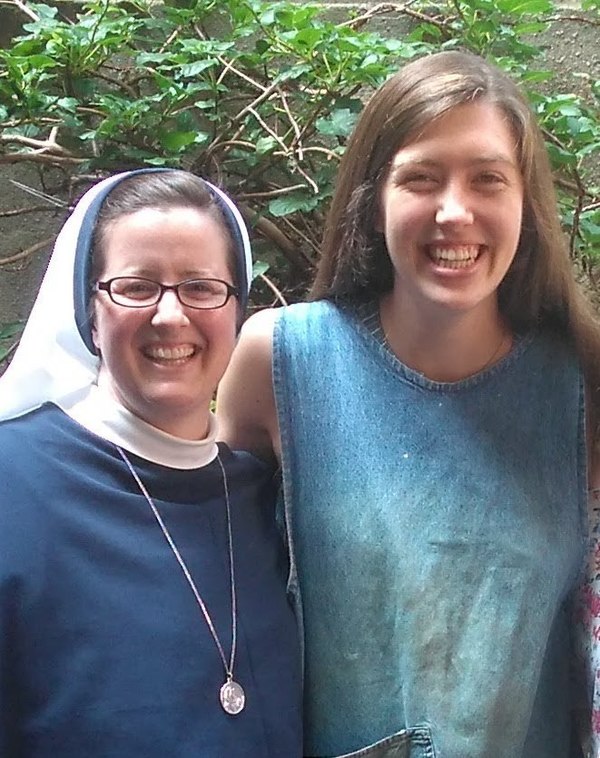
Just three months ago I left Rome after a semester of study abroad bursting with gratitude for the ways in which this eternal city revealed the Church, the world, and myself to me. I left feeling part of something so big that my lifetime could catch only a small glimpse of it; and I also left feeling like I belonged to something so intimate that only I could share glimpses of it to those around me. This was Rome: ancient, yet present; global, yet personal; rich, yet poor. This was the Church I encountered there: universal, yet particular; one, yet diverse; old, yet new; broken, yet holy; holy, yet broken. I found these dichotomies at times invigorating and at other times perplexing. But, through my six months of experiencing them as a daily reality, I slowly began to understand how they are not separate from me, but my own beautiful reality as well, one that God constantly invites me into. By themselves, opposites easily become fractures. With God, they become opportunities to experience His transcendent and unifying presence in our lives. Rome, for me, was this encounter with God’s unifying presence in my own heart, in my vision of the world, and my understanding of the universal Church.
Now as I return to Rome with a group of young people for the Synod on Young People, the Faith and Vocational Discernment, I am filled with anticipation at how God wants to reveal His presence to each and every one of us. As young people, we know the dichotomies of our hearts well. Desires and fears call us in many directions. We are all trying to discover where we are called and seeking to understand who we are. During this week, we will encounter a new part of the world and the Church—and hopefully a new part of our hearts. God will ask us to look outside of ourselves and He will also ask us to look inside. The challenge is letting His presence pervade both what we see outside and what we discover inside. I pray that we, as youth, will let His presence unify our lives, internal and external and I pray that this Synod might be a time for the Church to help young people as we seek to let our Faith and our Discernment become one under God’s guiding presence.
David Bender (Sophomore)
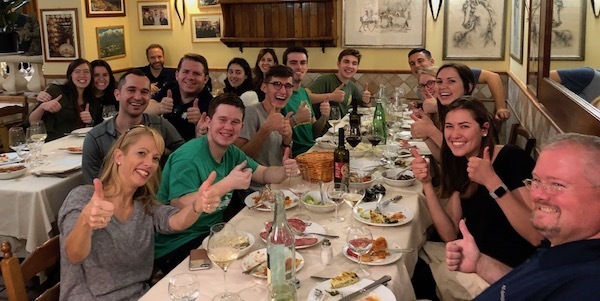
Today marked the beginning of the Sorin Fellows’ pilgrimage to Rome for fall break. Despite being jet-lagged from the long flight over from the States, we were still able to pack in a full day’s worth of activities. In the morning, we were treated to a brief tour of the area surrounding our residence near the Vatican. As a history enthusiast, it was fulfilling being able to finally visualize many of the places I had read about and studied before. At around 1 o’clock we took a break for lunch, dining at L’Orso 80. It became apparent early on that dining is far different in Italy than it is in the United States. Rather than ordering off a menu, the staff brought us a series of appetizers over the course of an hour and a half. The variety of foods was quite overwhelming, as they brought everything from onions to salami; there was undoubtedly enough food for everyone (and then some).
After lunch and a brief period of down time, we headed to Mass at the Vatican, at St. Anna. We were lucky to have Fr. Wojciech Giertych OP, the Theologian of the Papal Household, preside. After Mass, Fr. Giertych treated us to a tour of his apartment and a discussion of the Church and its relationship to economics and politics, as well as the supernatural abilities of the Holy Spirit. The discussion was incredibly valuable because we were able to hear an irreplaceable perspective on the matter from Fr. Giertych. Following the discussion, we closed the day with dinner at Isola Della Pizza for an excellent meal of antipasti, pastas, and desserts as well as fraternization. Overall, the first day offered an excellent mix of learning from both a historical and theological perspective, as well as several opportunities to experience authentic Italian culture.
John Paul Ferguson (Junior)
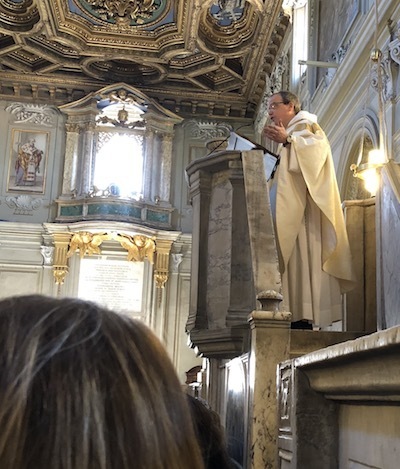
This morning, our Sorin Fellows contingent began its first full day in the Eternal City! After a quick Italian breakfast of coffee, bread, and Nutella, we worked our way through the city to the Basilica of San Clemente, located next to the Coliseum. The usual Catholic pilgrimage staples were all in place: Mass, a time for prayer, a tour of the church, and closing benediction, but our group was particularly blessed to share these with some quite special people. The Mass was celebrated by Fr. Thomas Joseph White OP, the American Dominican who founded the Thomistic Institute and has since been reassigned to Europe to spearhead similar efforts on the continent. Our tour of the basilica was led by Professor Elizabeth Lev, another Rome-based American and world famous art historian and scholar. Professor Lev took us through all three levels of the church, from the main level built in the 16th century, down to its original 3rd century foundations.
As Professor Lev explained, the basilica's namesake Saint Clement, the fourth pope (reigned 88 A.D.–99 A.D.), was likely a freed Jewish slave who took his master's Roman name. His master—the original purchaser of the prime real estate next to the Coliseum—was likely a cousin of the emperor. The church of San Clemente, at one point the original apostolic palace of the Pope, was in essence brazenly set up by cheeky Christians immediately next to the notorious location of the martyrdom—previous, ongoing, and yet-to-be-suffered—of hundreds of their peers. The ancient church today stands as a monument to the bravery of the early church despite its persecution, as the vanguard of the infiltration and eventual takeover of the great Roman empire by a one-time small-town group of Jewish rabble-rousers.
What confidence those early Christians had, undaunted by the magnitude of the Imperium. And where does the Roman Empire now stand? Its Coliseum stands as a massive ruin, no doubt a spectacle to behold, yet nevertheless an empty shell of what it once was. Whereas the Basilica of San Clemente still stands, rebuilt multiple times through the years, still welcoming pilgrims within its walls, still pulsating with the vibrant life of the Church.
Keenan White (Senior)
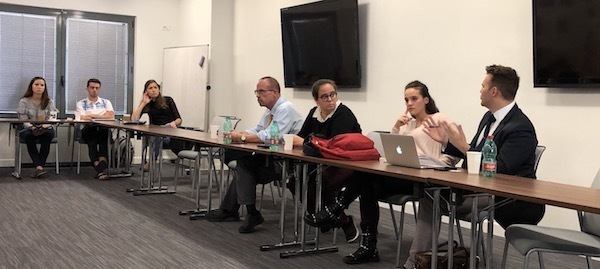
The particulars of the complex structure of the Synod of Bishops and its dynamic history may have been far from the forefront of our minds upon arrival in Rome. Yesterday, however, a presentation by journalists from Crux revealed the importance of such matters in evaluating the conclusions and significance of this month’s meeting.
Crux’s presentation was eye-opening and, frankly, raised concerns about the efficacy of the synod system. For those unfamiliar with the process by which the final document is created, the particularly daunting task of synthesizing the concerns of the youth of the world—from South Bend to South Africa to South Korea—can sound like a losing battle.
We were challenged to think about the ways in which such a system disproportionately burdens poorer dioceses and potentially disservices the problems of world youth by taking on such a breadth of issues without the ability to account for the relative severity of each. For example, while the sexual abuse scandal looms large for bishops of many Western countries (the United States among those most affected), other dioceses, particularly in the Middle East, face widespread Christian persecution. Both are issues well worthy of address, but neither can necessarily be given the attention it deserves within the limited timeline and broad scope of a synod.
It was proposed that a potential solution to both of these legitimate concerns could be to begin such discussions at the local level, starting within individual dioceses and extending to the regional, national, and continental levels in turn before culminating in a conversation convoked by the Vatican. In such a way, the focus could be less on the particular problems of each region, and more about synthesis: incorporating the findings of each region into a wide-reaching document that could address prevailing themes found across the many.
As the Church moves forward towards greater transparency and lay participation, reevaluation of the synod system may be in order. It may be worth taking a step back to evaluate whether this tradition is serving the needs of the Body of Christ in the most effective way.
Noelle Johnson (Junior)
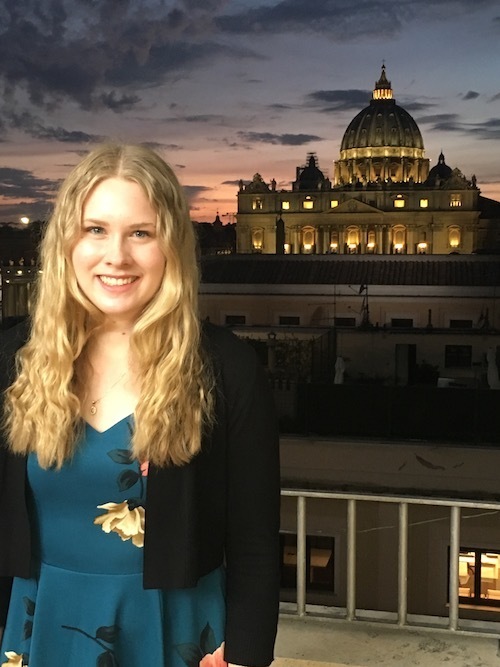
This morning we visited the Missionaries of Charity in Rome, and in yet another of the week’s many sainthood-inspiring moments we visited the room in which St. Mother Teresa stayed when she visited the Eternal City. After a moment of prayer in her room, I stepped across the corridor to the sisters' chapel, where I saw the day's saints to be celebrated written on a small whiteboard. Call it a happy accident or, more likely, divine providence, as I realized that it was the feast day of my confirmation saint! October 16th is the feast of St. Margaret Mary Alacoque, who received visions of the Sacred Heart of Jesus and began the devotion to his Sacred Heart. Kneeling in the chapel, with Mother Teresa’s favorite phrase “I Thirst” written on the wall next to the crucifix, and the Sacred Heart in my mind, was a grace-filled reminder of God’s infinite love for us.
Scripture expresses this best: “For God so loved the world that he gave his only Son, that whoever believes in him should not perish but have eternal life” (John 3:16). In Jesus Christ, and in the Eucharist, God gives himself totally to us so that we can share in his life. As Catholics, we have the beautiful gift of the Church, which safeguards the treasure of the Eucharist and everything else that God has revealed to us, including his moral and doctrinal teaching. This is so that we might have access to these great graces throughout the centuries, so that as many as possible can live a life informed by what God has shared with us about himself, and so that we might always aim towards eternity with him. The greatest gift that the Church can give to the youth of today is what Jesus instituted the Church to protect: the Eucharist and his teaching about living lives conformed to himself.
It would be a tragedy for the Synod on "Young People, the Faith, and Vocational Discernment" to try to offer the youth of the world anything else. St. Paul writes in the Letter to the Colossians, “So, as you received Christ Jesus the Lord, walk in him, rooted in him and built upon him and established in the faith as you were taught, abounding in thanksgiving. See to it that no one captivate you with an empty, seductive philosophy according to human tradition, according to the elemental powers of the world and not according to Christ” (2:6-8). Jesus thirsts for each of us and wants to give us his Sacred Heart. It is because of this that he has shared himself with us and taught us how to live a life in accordance with his will. The youth of today, with our unique generational challenges, thirst for the truth that only Christ can give us. This is what the Church should share as well—Christ, and not an empty human philosophy.
John Hale (Sophomore)
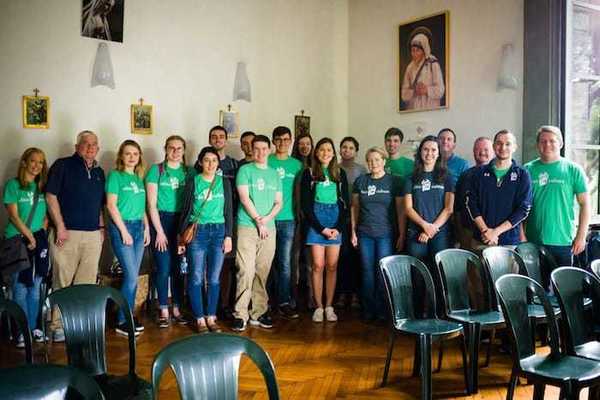
This morning, our group had the opportunity to serve with the Missionaries of Charity sisters at their shelter for homeless men at San Gregorio al Celio. Working with these sisters, whose vocation it is to serve the impoverished as contemplatives in action, was the most impactful experience I’ve had on this pilgrimage so far. Upon arrival, we were blessed to be able to pray in the very room Mother Teresa stayed in when she came to Rome. After we prayed, the sisters split us up into three groups. One group worked to produce Mother Teresa relic cards—3,000 in all!
Katherine and I worked with Sister Marie Xavier to clean the bathrooms and scour the floors, hallways, and walls. While we were cleaning, we got to talk with several of the men living there. This was a very humbling experience because while many of them could not walk, they were the kindest of souls. One man, Andrea, served in the Polish Army in World War II. He kept Katherine and I company, joking around with us and assuring us that we will be in his prayers. When the sisters rang the bell for lunch, several of the men who could walk helped those who couldn’t make it down the stairs on their own.
It was so beautiful to see the genuine care these men had for their brothers. This beauty-in-action was taken to another level when I realized that these men, who don’t have families, were impacted by the witness of the sisters who so joyfully care for them. Seeing the pure joy in the sisters’ eyes and hearing the love in their laughter brought me a sense of profound peace I have not experienced anywhere else.
My favorite part of serving with the Missionaries of Charity was bringing the men their lunch and getting to talk with them. Giorgio, who Sister told me was in his 50s, was unable to walk or stand up on his own. Giorgio had the sweetest eyes and I was extremely drawn to him! As the men slowly left their tables, one by one, Andrea looked back at me in his Red Sox cap and said “God bless you.” I was so grateful and honored to have such a kind, holy soul asking God to bless me.
The previous night, my roommate and I were talking about what it means to answer the Lord’s call to love Him radically, and our conversion was on my mind all day during our time with the sisters. When we received the relic cards which our fellow students had produced, we decided to choose them at random—each card had a different quote from St. Mother Teresa. The one I pulled said “Learn to love until it hurts.” I got chills immediately, taking it as a direct message from Jesus through his servant Mother Teresa.
I will never forget this day of service and the impact these sisters’ joy had on me! Today, God put on my heart a desire to dig deeper and learn how to love. To love as these sisters love. To love with the joy that these men have.
We are all called to love until it hurts, imitating the perfect witness of Jesus in his passion, death, and resurrection.
Clementine Ganley (Sophomore)
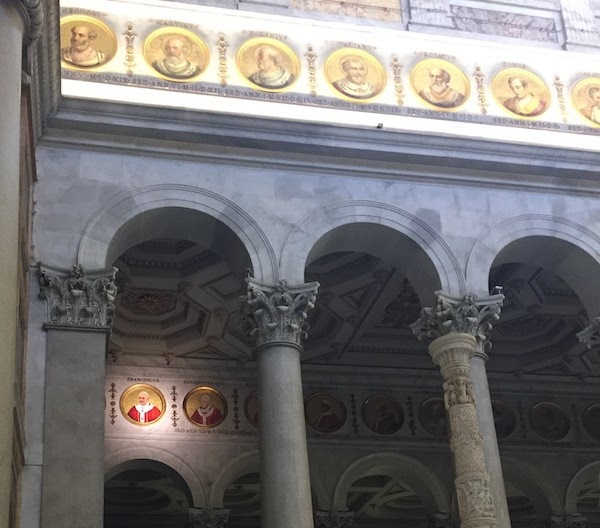
This morning our group visited the papal basilicas of St. John Lateran, St. Mary Major, and St. Paul Outside the Walls. All three of these holy places, while different, had something in common. Each place was filled with unique and beautiful artwork that has helped to communicate the stories and lessons found in our Sacred Scriptures to the faithful over the centuries. The art also served to commemorate the important figures of the time or those who contributed to their construction.
The different artistic styles found in the basilicas assist in the communication of the divine message. The statue of the Apostle Matthew in the Lateran invites us to contemplate wealth and what we are willing to give up as followers of Jesus. The mosaics along the walls in St. Paul’s that depict the popes that have come before—and our current Pope Francis—invite us to contemplate the future of the Church when we see the blank spaces that will be filled with the likenesses of future popes.
The artwork found in these places are not only historically significant, but are relevant to us as well. No matter what time we are living in, the message of Jesus is always the same. These images bring to life the stories and lessons in scripture in a way that all ages can understand. They are as relevant today as they’ve ever been. Beauty truly does draw us closer to God. The artwork I marveled at today invited me to contemplate the mystery of the divine. These depictions of the sacred that surrounded me have inspired me to raise my eyes to heaven.
Daniel Lindstrom (Senior)

This afternoon was mostly an opportunity to recuperate (nap) from the pilgrimage thus far. I found the rest to be a nice change of pace from the time-intensive schedule the journey’s first half had demanded, and it allowed for a moment of reflection on what we have already seen, heard, and experienced in Rome together. My thoughts were first to examine the afflictions felt by modern youth, and then to contemplate the nave of the Basilica of St. John Lateran, where the late-Baroque era statue of the Apostle Matthew offers a pivotal message, particularly to young people as we move forward from the Synod.
It’s been well documented that our generation is both marked by an addiction to achievement and plagued by the woes of deteriorating mental health. My peers’ first concerns are with resumés, job offers, and interviews, and the drive for accomplishment is no stranger to me, either. When I am honest with myself, I find, as I think many of us would, that I am far too invested in worldly status or acclamation. We obstinately insist to ourselves that a good test grade, a well-paying job, a beautiful home—you fill in the blank—will finally satisfy us. Yet, in reality there is only one source of satisfaction, and that is what kept me thinking of Matthew as the day went on.
We went on three Basilica visits today, the first of which was to St. John Lateran. Inside, all of the Apostles are sculpted in large, striking figures. Our guide, Professor Liz Lev, pointed out Matthew in particular as she said, “Matthew is depicted with a bag of money at his feet, spilling out over the edge. It’s almost as if he were telling us to look at everything he had given up in order to follow Christ, asking us, ‘Would you do the same?’” Instantly that brought to mind the rich young man of Matthew’s Gospel.
As Jesus was teaching his disciples, a young man asked Him how to gain eternal life, and Jesus responded by instructing the man to keep the commandments. When the man insisted he had done so, the story goes like this:
Jesus said to him, “If you would be perfect, go, sell what you possess and give it to the poor, and you will have treasure in heaven; and come, follow me.” When the young man heard this, he went away sorrowful; for he had great possessions. (Matt. 19:21-22)
As we ruminate on young people and our relationship with the faith, I don’t believe it to be coincidental that the man who approaches Jesus is also young. Like us, he faces tension between this world and the one to come. However, thanks to him we know the outcome of the decision. Will we be strong enough to seek fulfillment in the one who yearn for us, following Jesus like Matthew? Or will we resign ourselves to the false promises of worldly pursuit, and go away sorrowful like the rich young man? For these next few days, and for every day after, I hope that we will take Jesus up on His offer to, “Come, follow me.”
Soren Hansen (Senior)
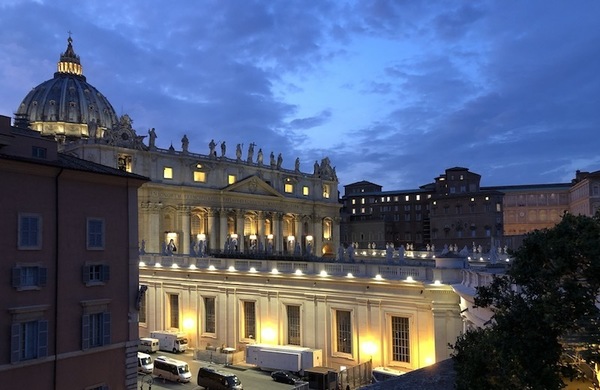
As we pass the midpoint mark on our incredible pilgrimage this week, we’re staying busy and staying inspired. I’d like to think I bring a special perspective to this trip since I’m a recent convert to the Catholic Church. Though I’m now just as much a part of this family as anyone else, I think I encounter this city in a slightly different way.
This is not my first time in Rome; I visited when I was in high school on a summer art history trip. So what has changed? Let me illustrate with an example. Today, we will visit the Church of the Gesú and tour the apartments where St. Ignatius of Loyola lived in Rome. I’ve been to this church before; in fact, on my first visit to Rome, it was my favorite—it turns out that counter-reformation grandeur has always been a part of my artistic palate.
All jokes aside, when I go to visit these places this time, the art remains the same: the same beautifully decorated ceilings and impressive chapels present themselves to my eyes. The same pews sit dutifully before the altar. The same statues watch over the sanctuary and the same tourists wander between the aisles, eyes fixed on the heavens portrayed above them.
Yet when I visit these churches this time, I get an intense feeling of belonging each time I enter. These are no longer merely places of intellectual history or art history. These places are part of my history, part of the history of my faith. Being able to attend Mass and receive the Eucharist in these places is a particular privilege in my eyes. Though I’m sure my fellow students are similarly grateful and moved by the experience of receiving the sacraments in the Eternal City, I feel a remarkable connection to the early Roman Christians themselves, the gentiles, the outsiders who were welcomed into the Church with open arms. I am, like them, moved by the art and beauty that was created to move to faith the people who cast their eyes upon it. I also am receiving the Body and Blood of Christ in these beautiful places for the first time, like many pilgrims and converts before me. St. Peter’s Basilica is no longer just an impressive building and a human engineering achievement, but it is also a beacon of truth and a symbol of home.
I feel incredibly blessed to have this particular perspective, and I hope the presence of a convert, a young person who freely chose to enter the Church in these often difficult times, will refresh the eyes and the faith of those who journey with me, especially those who take for granted their place among the loving family of the Church. I am so blessed.
Zachary Pearson (Sophomore)
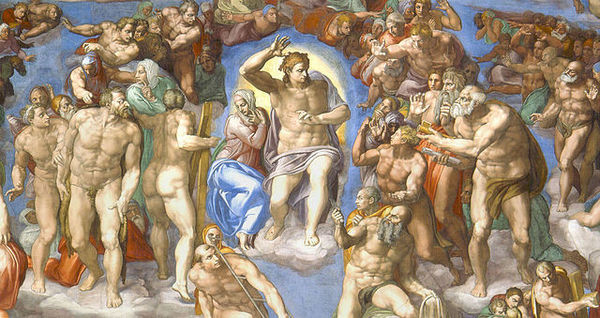
“Miserere Mei Deus, Secundum Magnam Misericordiam Tuam”—Psalm 51
This really sums up my fifth day in the Eternal City. Today, I had the opportunity to return to the starting point of my journey to Catholicism—the Sistine Chapel. My “reversion” story centers around this deeply sacred place. I was in eighth grade when I first came to Rome, at that point almost entirely agnostic/atheist, and visited the Sistine Chapel. That moment is seared into my memory. I had a profound spiritual experience as I gazed at The Last Judgment and the rest of Michelangelo’s masterpiece. I closed my eyes after a perfect final view of the chapel and had my Dad walk me out. The whole experience caused me to reconsider my convictions and started me on the road to discover my Catholic faith, now the most important part of who I am.
With this in mind, it’s easy to see that I was overwhelmed with the prospect of return. I had no idea what to expect. As I walked in, my heart beating out of my chest, it was all I could do not to cry. I spent what truly seemed to be an eternity at prayer. Eventually, a priest walked in and began to hear confessions right next to the altar. I went to the line, and received the sacrament where I began my journey. I walked back to the center of the chapel and my friends walked me out, eyes closed after another perfect final view, just like my dad did 6 years ago. To experience the fullness of God’s mercy in the most important place in my faith life was an unimaginable experience. I know I’ve yet to fully grasp the significance of it all. But all the same, my heart sings out the glorious mercy of God and love for His Holy Church.
Tomorrow promises to be yet another deeply moving day as we move through time at St. Peter’s Basilica. We will hear Mass at the Christo Rey Altar, tour the Basilica with the indomitable Professor Liz Lev, and go on the Scavi tour of the catacombs and the foundations of the original St. Peter’s. It will be a day of reflection on the unity of the Church, the historicity of the See of Peter, Her incredible artistic heritage, and Her timelessness. Today I revisited one of the most important experiences of my life; it is with this full heart that I look forward to the incredible day to come.
Grace Enright (Junior)

We have arrived at our pilgrimage’s end in Rome. While mulling over our final day of adventure and prayer, I found myself focusing on one unyielding query put forth to us again and again this week – “Who do you say that I am?”
Its answer has been whispered to us in the quiet, simple peace of St. Ignatius’s chapel, shouted in the splendid glory and immensity of St. Peter’s Basilica, glimmered in the light of the mosaics of San Clemente, and etched, graffiti style, on the earliest Christian gravestones.
It was, however, in our final tour of the week that the profundity of the Christian reply to this question was made most present to me. The Scavi excursion today brought us into cramped, humid paths two stories below the Basilica of St. Peter. There, in the dim light of the Necropolis, the words “You are the Messiah, the Son of the Living God” were read aloud from Matthew’s Gospel as we looked upon the jaw of the simple fisherman who first spoke them.
All of the beauty we have encountered this week, the witness we have sought to share, the Church herself, rises and falls on the answer to this question. It is the question posed to the martyrs in whose footsteps we have walked and the saints whose statues watchfully adorn St. Peter’s Square. It is the question the Synod, fundamentally, is presenting to the youth of the world, and attempting to accompany them as they seek the Truth. It is the question we have posed to ourselves and each other this week, in our conversations, in our interactions, and in our prayers.
The incredible Professor Liz Lev concluded our tour of St. Peter’s today on the porch of the Basilica. There she drew our attention to the arms that wrap around the Square, gathering in the pilgrims who come to pay their respects. Bernini’s original plans called for the arms to meet, to effectively close off the Square from the rest of Rome. Instead, however, a wide gap remains at the top and pilgrims pour in through that space every day. But just as they enter in, they are sent forth out again.
This pilgrimage has been an unbelievable blessing for all of us young people this week. Where we have entered in, in our states, our studies, in our relationships, we are called out again. We will return, in a short while, to the ordinariness of the everyday – class, tests, papers, dining halls– but this time we will be rejuvenated with the answer we have found everywhere where we turn in Rome: ““You are the Messiah, the Son of the Living God.”
Soren Hansen (Senior)
I’m sorry to leave the Eternal City, but I leave filled with hope. I’ve connected with young people and clergy members this week in incredible ways, and was inspired by the faith and commitment to Truth that I saw in everyone involved in this pilgrimage and synod. While there are many signs of decay around Rome and many reasons to be pessimistic about the future of the Church, the oldest bricks laid by the early Christians - the ones that lie far beneath St. Peter’s Basilica bearing the weight of the Church today - are a testament to the lasting presence of the Bride of Christ. The young people of this global family must rise to the occasion and testify to the Truth of the Incarnation today so that our children may be the witnesses of tomorrow.
